Brothers Stephen and Darren Buckley operate a tillage farm and contracting enterprise in Riverstick, Co Cork, almost halfway between Cork city and the coastal town of Kinsale.
The Buckley family have been growing crops on their farm in Glendooneen for more than three generations, consisting mainly of winter wheat, barley, oats and rape, as well as malting spring barley and oats.
Contract sowing and cutting is also carried out, with the Buckleys having some long-term customers.
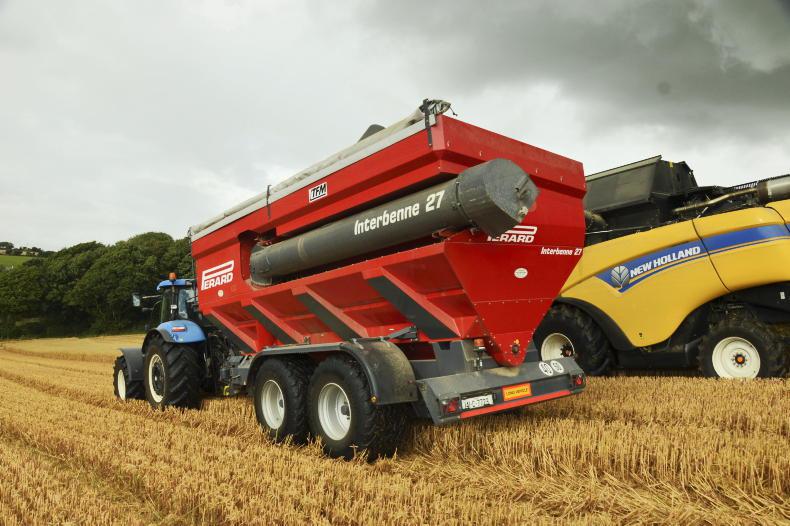
Augers are operated using the tractor's PTO while all other functions are controlled using four spool valves. Therefore, no control box is needed.
The Buckleys have a long-standing tradition with Ford and New Holland, operating primarily New Holland tractors ranging from TM155s to a T7.270 BluePower from Mc & S Agri Sales, while Kuhn tillage equipment from Cork Farm Machinery works the soil.
Every stable has a dark horse and it is no exception with the Buckleys, with a solitary Massey Ferguson 7726 tucked into the fleet.
A Renault Premium handles haulage duties along with tractors. Last year, a tractor-drawn dolly was purchased to give more flexibility with the artic trailers in the field, especially in soft conditions.
General maintenance is carried out in-house, with Chris Whitehead looking after major repairs and servicing and maintaining the combines.
Combines
The brothers’ late father, Vincent, was both a progressive tillage farmer and a keen machinery enthusiast, always striving to expand the farming and contracting business.
In the pursuit of output and efficiency, John made the decision to purchase a second combine 10 years ago which greatly increased their harvesting capacity. Today, the Buckleys run a New Holland CX8080 Elevation and CX8070 with 25ft and 20ft headers, respectively, capable of 45 to 50 acres per combine a day in optimum July conditions.
Looking to further increase output and take full advantage of harvesting windows, the Buckleys had been toying with the idea of a chaser bin for a few years.
Having researched various bins and spoken with many owners, the brothers were on the lookout for a clean secondhand example for the 2021 harvest. A Perard Interbenne 27 with a few seasons under its belt was located in Leinster Farm Machinery.
Manufactured in Verdun, France, the Interbenne 27 has a 27,000l capacity, equating to approximately 21t of barley and 24t of wheat.

The chaser is equipped with a hydraulically suspended drawbar.
A well-specified machine, the Buckleys’ chaser bin is complete with hydraulically suspended drawbar, air over hydraulic brakes, rollover cover and inside walking platform.
Interestingly, the Perard bin has a swingout-type unloading auger – similar to a combine – which allows it to empty in any position, including fully folded.
This also allows the bin to stay out further from the trailer, giving the operator greater vision when filling.
Perard is imported into Ireland by agent Templetouhy Farm Machinery, Clonmel.
The chaser bin has been a great
success, with Stephen and Darren
noticing a significant increase in output.
Firstly, the combine’s sole function is now to do what it is intended to do the whole working day without any unloading downtime.
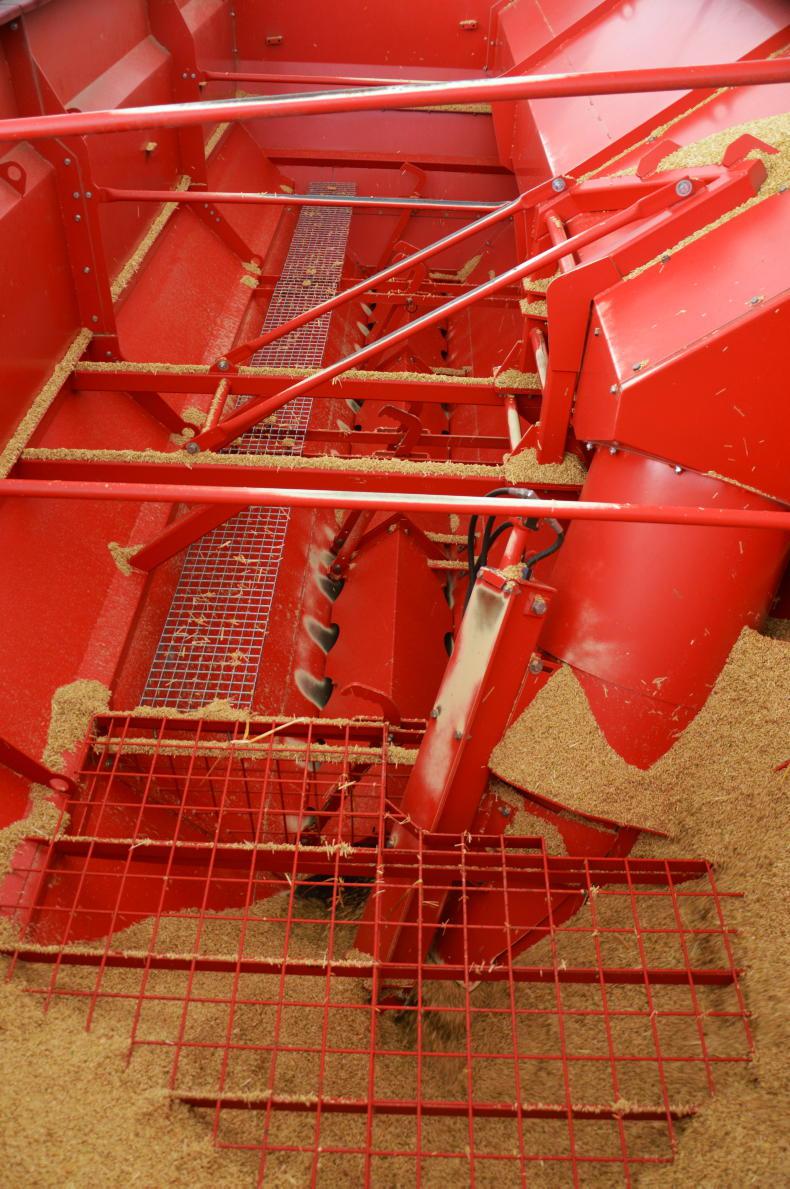
The Buckleys like the fact that the floor auger doors can be closed for greater control when topping off loads.
While Stephen acknowledges that unloading into trailers on the move has its place, a combine must still stop to top off and fill the load fully.
Combines are consistently harvesting when conditions allow, making the most of any small window in the weather.
Unloading on the move also has the clear benefit of the combines continuing to make progress through the crop.
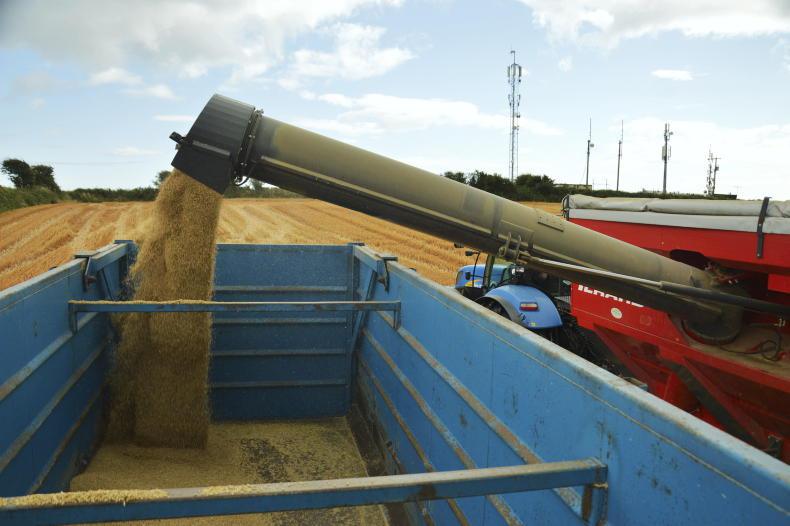
The chaser bin can unload in under one minute.
Headlands are now considerably easier to open as the bin can follow both combines around the field. Trailer management is much simpler, with trailers now staying close to the field entrance.
This has the added benefit of reduced levels of soil compaction as well as allowing loads to be fully filled in soft conditions.
A New Holland 7060 provides ample grunt for pulling and while over its job, the tractor’s weight is required to boss the chaser bin. Despite a top-heavy look, the chaser bin is described as very stable, with the steering axle a great benefit for tight spots or to follow the sward of straw to reduce tramping.
The sprung running gear has great clearance, with the wide wheelbase of over 3m receiving great praise for its ability to avoid the straw, while the 700 tyres keep the bin floating on the soil with operator Ivan Clarke reporting the bin to be easy to pull, even on high ground.

Once full, the chaser is used to fill trailers at the headland, reducing traffic in the field.
The wide opening of the top of the chaser bin also adds flexibility with unloading from combines with different size headers, as in the Buckley’s case.
The chaser bin augers are run through the tractor’s PTO, with the rest of the functions controlled hydraulically using four spool valves.
The absence of control boxes or electrics is refreshing, and adds simplicity to the machine which is not lost on Stephen and Darren. A feature that is particularly liked by the operators is the ability to close the door to the floor auger, allowing greater control when topping off loads, while also emptying the main auger fully of grain.
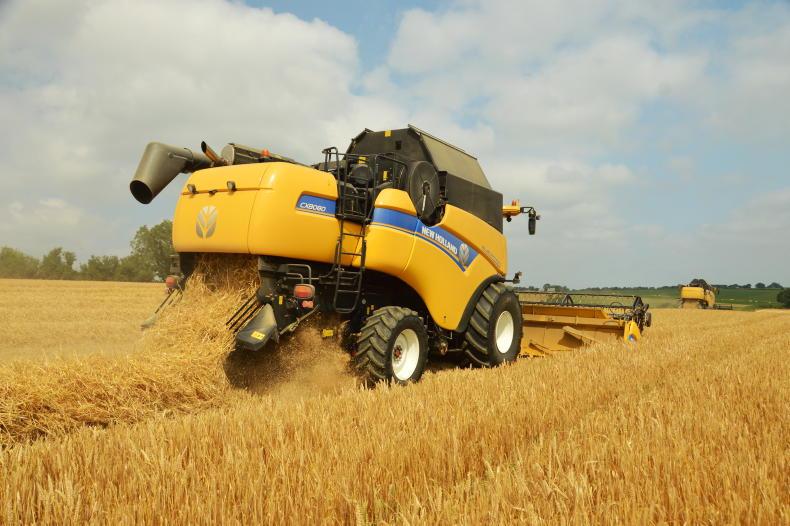
The move to a chaser bin has significantly increased output of each combine as there is now no time lost unloading.
Perspex windows at the front of the bin let the operator monitor progress of loading and unloading. The rollover cover allows the bin to double up as trailer at night if grain stores are closed and the walking platform inside the body is useful for routine inspections.
Rhythm
Typically, the two combines work together with the chaser bin tending to both. While the Interbenne 27 has ample capacity to carry a third combine tank, the Buckleys have found a smooth rhythm taking a tank from each combine, with the chaser bin returning to trailers where unloading is achieved in close a minute. This also eliminates any racing to return to the combines in larger fields.
While not under pressure, the chaser operation is definitely kept busy tending to the two combines and filling trailers.
Since its arrival, Stephen and Darren’s Perard chaser bin has more than proven its worth in the fleet, with the combines never static in the field unloading, or having to the leave the crop mid-sward to unload into a trailer on the headland.
“Now that we have the chaser bin, we wouldn’t be without it,” says Stephen. “It has significantly increased the output of the combines.”
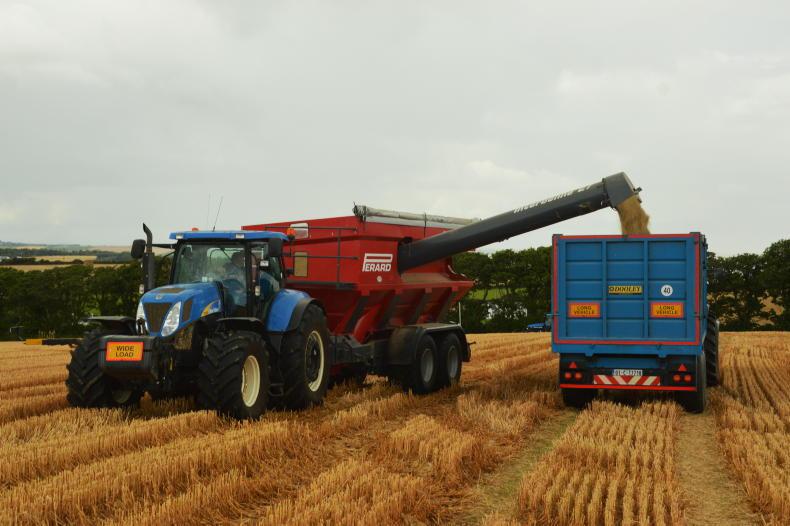
The Interbenne 27 has the capacity to carry 21t of barley or 24t of wheat.
The Buckleys estimate that each combine has an increase in harvesting output of between 15% and 20%, which is very impressive.
While there may not be any saving in diesel consumption, diesel being burnt by the combines in the field is just for harvesting, eliminating diesel being burnt travelling to unload or solely unloading.
The Buckleys have no regrets about purchasing their chaser bin.
It has added both output and efficiency to their harvesting operation. The bottom line is, it’s all about keeping those combines moving.
Spec
Model: Perard Interbenne 27.Capacity: 27,000l (27m3).Discharge auger diameter: 500mm.Unload time: sub 60 seconds.Length: 8.8m.Width: 2.54m (without wheels).Height: 3.5m.Unladen weight: 7.9t.Tyres: Vredestein 700/50 R26.5.
Brothers Stephen and Darren Buckley operate a tillage farm and contracting enterprise in Riverstick, Co Cork, almost halfway between Cork city and the coastal town of Kinsale.
The Buckley family have been growing crops on their farm in Glendooneen for more than three generations, consisting mainly of winter wheat, barley, oats and rape, as well as malting spring barley and oats.
Contract sowing and cutting is also carried out, with the Buckleys having some long-term customers.

Augers are operated using the tractor's PTO while all other functions are controlled using four spool valves. Therefore, no control box is needed.
The Buckleys have a long-standing tradition with Ford and New Holland, operating primarily New Holland tractors ranging from TM155s to a T7.270 BluePower from Mc & S Agri Sales, while Kuhn tillage equipment from Cork Farm Machinery works the soil.
Every stable has a dark horse and it is no exception with the Buckleys, with a solitary Massey Ferguson 7726 tucked into the fleet.
A Renault Premium handles haulage duties along with tractors. Last year, a tractor-drawn dolly was purchased to give more flexibility with the artic trailers in the field, especially in soft conditions.
General maintenance is carried out in-house, with Chris Whitehead looking after major repairs and servicing and maintaining the combines.
Combines
The brothers’ late father, Vincent, was both a progressive tillage farmer and a keen machinery enthusiast, always striving to expand the farming and contracting business.
In the pursuit of output and efficiency, John made the decision to purchase a second combine 10 years ago which greatly increased their harvesting capacity. Today, the Buckleys run a New Holland CX8080 Elevation and CX8070 with 25ft and 20ft headers, respectively, capable of 45 to 50 acres per combine a day in optimum July conditions.
Looking to further increase output and take full advantage of harvesting windows, the Buckleys had been toying with the idea of a chaser bin for a few years.
Having researched various bins and spoken with many owners, the brothers were on the lookout for a clean secondhand example for the 2021 harvest. A Perard Interbenne 27 with a few seasons under its belt was located in Leinster Farm Machinery.
Manufactured in Verdun, France, the Interbenne 27 has a 27,000l capacity, equating to approximately 21t of barley and 24t of wheat.

The chaser is equipped with a hydraulically suspended drawbar.
A well-specified machine, the Buckleys’ chaser bin is complete with hydraulically suspended drawbar, air over hydraulic brakes, rollover cover and inside walking platform.
Interestingly, the Perard bin has a swingout-type unloading auger – similar to a combine – which allows it to empty in any position, including fully folded.
This also allows the bin to stay out further from the trailer, giving the operator greater vision when filling.
Perard is imported into Ireland by agent Templetouhy Farm Machinery, Clonmel.
The chaser bin has been a great
success, with Stephen and Darren
noticing a significant increase in output.
Firstly, the combine’s sole function is now to do what it is intended to do the whole working day without any unloading downtime.

The Buckleys like the fact that the floor auger doors can be closed for greater control when topping off loads.
While Stephen acknowledges that unloading into trailers on the move has its place, a combine must still stop to top off and fill the load fully.
Combines are consistently harvesting when conditions allow, making the most of any small window in the weather.
Unloading on the move also has the clear benefit of the combines continuing to make progress through the crop.

The chaser bin can unload in under one minute.
Headlands are now considerably easier to open as the bin can follow both combines around the field. Trailer management is much simpler, with trailers now staying close to the field entrance.
This has the added benefit of reduced levels of soil compaction as well as allowing loads to be fully filled in soft conditions.
A New Holland 7060 provides ample grunt for pulling and while over its job, the tractor’s weight is required to boss the chaser bin. Despite a top-heavy look, the chaser bin is described as very stable, with the steering axle a great benefit for tight spots or to follow the sward of straw to reduce tramping.
The sprung running gear has great clearance, with the wide wheelbase of over 3m receiving great praise for its ability to avoid the straw, while the 700 tyres keep the bin floating on the soil with operator Ivan Clarke reporting the bin to be easy to pull, even on high ground.

Once full, the chaser is used to fill trailers at the headland, reducing traffic in the field.
The wide opening of the top of the chaser bin also adds flexibility with unloading from combines with different size headers, as in the Buckley’s case.
The chaser bin augers are run through the tractor’s PTO, with the rest of the functions controlled hydraulically using four spool valves.
The absence of control boxes or electrics is refreshing, and adds simplicity to the machine which is not lost on Stephen and Darren. A feature that is particularly liked by the operators is the ability to close the door to the floor auger, allowing greater control when topping off loads, while also emptying the main auger fully of grain.

The move to a chaser bin has significantly increased output of each combine as there is now no time lost unloading.
Perspex windows at the front of the bin let the operator monitor progress of loading and unloading. The rollover cover allows the bin to double up as trailer at night if grain stores are closed and the walking platform inside the body is useful for routine inspections.
Rhythm
Typically, the two combines work together with the chaser bin tending to both. While the Interbenne 27 has ample capacity to carry a third combine tank, the Buckleys have found a smooth rhythm taking a tank from each combine, with the chaser bin returning to trailers where unloading is achieved in close a minute. This also eliminates any racing to return to the combines in larger fields.
While not under pressure, the chaser operation is definitely kept busy tending to the two combines and filling trailers.
Since its arrival, Stephen and Darren’s Perard chaser bin has more than proven its worth in the fleet, with the combines never static in the field unloading, or having to the leave the crop mid-sward to unload into a trailer on the headland.
“Now that we have the chaser bin, we wouldn’t be without it,” says Stephen. “It has significantly increased the output of the combines.”

The Interbenne 27 has the capacity to carry 21t of barley or 24t of wheat.
The Buckleys estimate that each combine has an increase in harvesting output of between 15% and 20%, which is very impressive.
While there may not be any saving in diesel consumption, diesel being burnt by the combines in the field is just for harvesting, eliminating diesel being burnt travelling to unload or solely unloading.
The Buckleys have no regrets about purchasing their chaser bin.
It has added both output and efficiency to their harvesting operation. The bottom line is, it’s all about keeping those combines moving.
Spec
Model: Perard Interbenne 27.Capacity: 27,000l (27m3).Discharge auger diameter: 500mm.Unload time: sub 60 seconds.Length: 8.8m.Width: 2.54m (without wheels).Height: 3.5m.Unladen weight: 7.9t.Tyres: Vredestein 700/50 R26.5. 












 This is a subscriber-only article
This is a subscriber-only article









SHARING OPTIONS: